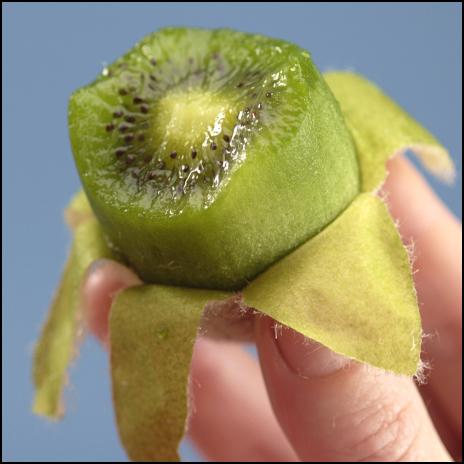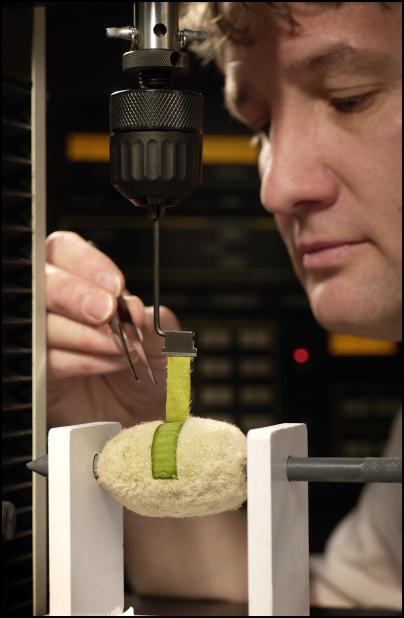Images: Peel Me A - Kiwifruit?
Peel Me A - Kiwifruit?
Media release - 7 July, 2003

Something to look
forward to - kiwifruit that peel like a
banana.
We already have easy peel mandarins, and of course we all know about bananas, now imagine peelable kiwifruit
Research has been done to see if it is possible to produce a kiwifruit that will peel with ease. No more cutting and spooning. Think what that would do for school lunches and quick snacks.
HortResearch scientists Dr Roger Harker and Dr Ian Hallett, know that marketing is all about consumer choice and for fruit that is driven by perceived differences in convenience and ease of eating. Regular eaters of kiwifruit tend to cut the fruit in half and scoop out the flesh with a teaspoon. Would it be better if it peeled the way a banana does?

The 'white mouse" of kiwifruit - A. eriantha Benth.
"The process of peeling requires a distinct zone of weakness to develop below the skin to allow clean separation from the flesh," Dr Harker said.
If such a zone does not exist then the skin will not peel easily, rather clumps of flesh will be torn away with the peel. In both banana and citrus fruit there are specific tissues that are biologically programmed to form these zones.
Another key factor for consideration is the ease with which the skin might tear during peeling.
Kiwifruit are from the genus Actinidia with a wide range of different skin types. One that is a white hairy fruit and is not too nice to eat, does have skin that is relatively easy to peel. If Dr Alan Seal and his breeding team at Te Puke are able to combine this characteristic with kiwifruit we like to eat they could produce acceptable peelable kiwifruit.

Using a machine to peel an A. eriantha kiwifruit. Scientist Roger Harker sees possibilities in using this white skinned kiwifruit as a parent for easy peel fruit of the future.
Sounds easy, but Drs Harker and Hallett discovered that there are a number of factors that confer peelability within Actinidia and some of these factors have not yet been fully characterised. On the positive side Dr Harker said that any single genotype needs perhaps only one or two of these factors to become an easy-peel product.
Ease of peeling is closely related to the ripening process. It is not until fruit are close to nearing ripe that the adhesion between skin and flesh drops to a level that allows easy detachment.
"Future research needs to focus particularly on identifying methods that allow the skin properties to be clarified," he said.
Then would come the traditional process of breeding the perfect peelable kiwifruit.
ENDS


 Master Plumbers Gasfitters and Drainlayers NZ: New Consumer NZ Test Reveals Danger Of Unregulated Online Plumbing Products
Master Plumbers Gasfitters and Drainlayers NZ: New Consumer NZ Test Reveals Danger Of Unregulated Online Plumbing Products Mindful Money: Winners At The Mindful Money Annual Ethical & Impact Investment Awards 2025
Mindful Money: Winners At The Mindful Money Annual Ethical & Impact Investment Awards 2025 MBIE: Gas Supply Reducing Faster And Sooner Than Previously Forecast
MBIE: Gas Supply Reducing Faster And Sooner Than Previously Forecast Natural Hazards Commission: International Markets Show Unprecedented Confidence In NZ’s Natural Hazards Insurance Scheme
Natural Hazards Commission: International Markets Show Unprecedented Confidence In NZ’s Natural Hazards Insurance Scheme  ASB Bank: ASB Business Survey - The Impact Of Trump's Tariffs, According To Kiwi Businesses
ASB Bank: ASB Business Survey - The Impact Of Trump's Tariffs, According To Kiwi Businesses University of Auckland: Will Robots Help Older People Stay Sharp?
University of Auckland: Will Robots Help Older People Stay Sharp?


